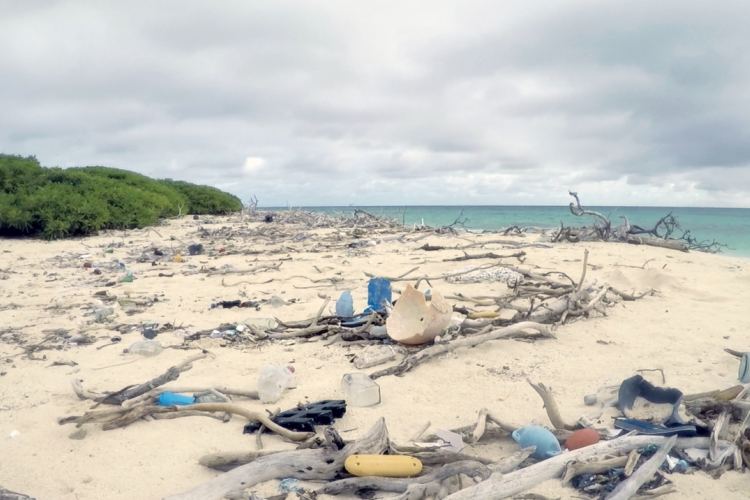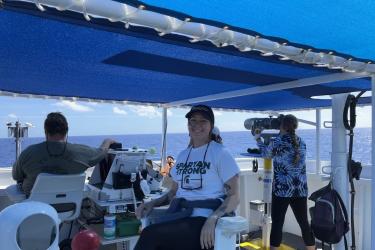Ten of our marine debris team members boarded the vessel Imua, along with partners from the U.S. Fish and Wildlife Service, for 16 days of cleaning up debris from islands and atolls in the Northwestern Hawaiian Islands, protected by the Papahānaumokuākea Marine National Monument.
It is fitting that we would be on this vessel for the final leg of our mission, as “Imua” means “to go/move forward” in Hawaiian.
Kure Atoll (known as Mokupāpapa in Hawaiian)
Moving forward, our first stop was Kure (pronounced “cure-ay”) Atoll. Kure is the farthest northern atoll in the chain and it is gorgeous. Our team on the Imua was blessed with fantastic weather to continue debris removal operations. We collected more than 6,800 pounds of plastics and nets from Kure’s Green Island. We also removed a 17.5-foot derelict fishing boat (possibly from the 2011 tsunami in Japan) that field staff had been trying to remove from the island for some time.

After only one day at Kure, it was time to head back to Pearl and Hermes Atoll (Holoikauaua), where we previously spent 10 days freediving to remove debris underwater, to trek the shorelines and collect land debris from the small islands in the atoll. Each year, Hawaiian monk seal researchers clean up and document debris accumulation while they are stationed at field camps on these remote islands studying monk seal populations.
Our team went to each of the small sand islands within Pearl and Hermes Atoll and picked up the debris that field staff collected in 2017 and 2018. We also cleared all of the beaches of nets and large buoys that had accumulated over the past year. Derelict fishing nets can be dangerous entanglement hazards for Hawaiian monk seals, and we removed a large net in the surge zone that several seals were curiously investigating. The U.S. Fish and Wildlife Service staff conducted bird and vegetation surveys on Seal Kittery Island, Grass Island, and Southeast Island.
Overall, we collected 13,244 pounds of debris from the islands in Pearl and Hermes Atoll!
Lisianski Island (Papa‘āpoho)
SO MANY flies!
Once again, moving forward, the team’s task at Lisianski Island was to remove several large super-sacks of debris that the field staff collected over two seasons. We really had to work together to remove such giant sacks of heavy debris—parbuckling and shouting a lot really seemed to help get the super-sacks of debris into the small boats.
Light winds make it easier to move a lot of heavy debris from the shore to the small boats and then make multiple runs back and forth from the island to the ship. However, on Lisianski, in light wind, the flies are merciless, covering your body from head to toe. Eating on the islands is not a pleasurable experience—you have to eat with one hand and swipe away flies with the other.
It must become a way of life for the wildlife that live there—the seals bury their heads in the sand. Many of us tried similar approaches, covering up as much skin as possible, but some members of our team were very resilient to being swarmed by flies and described the feeling to be, “like a moving shirt.”

Even covered in flies on Lisianski, we were able to haul away all previously collected debris. We also removed some additional entanglement hazards including one massive tangled ball of nets that weighed more than 2,200 pounds. After all our hard work, we cleared 15,500 pounds of debris off the island.
Laysan Island (Kauō)
This island is absolutely beautiful, but the shores had the largest amount of trash we encountered during the entire trip. Laysan has 7 miles of coastline and pristine white sand beaches. This island, like all the others, is filled with wildlife: curious young Hawaiian monk seals and juvenile booby birds that fly close overhead inspecting their new visitors and sometimes even land on your head.

Interestingly enough, there are curious Christmas tree wrasses that swim up to you on almost all the coastlines. Laysan was quite a paradise, with not as many flies as Lisianski, but still quite a few flies swarming overhead. The team spent 4 days there and successfully removed all the collected debris, in addition to all the new accumulation and entanglement hazards. We also grabbed a problem net that had been in a prominent Hawaiian monk seal pupping area on the northwest tip of the island for a few years.
There is a distant shoreline of Laysan, along the southeastern coast, that is inaccessible by small boat. So, our team had to haul nets and plastic debris along 1.8 miles of beach in an exhausting, long haul back and forth. Our team of 10 worked very hard and made two round-trips, each day for 2 days, to remove more than 8,200 pounds of debris!

French Frigate Shoals (Kānemiloha’i)
French Frigate Shoals was the next and last atoll we visited to remove debris and assess the damage caused by Hurricane Walaka. During the storm, hurricane-force winds and a large storm surge hit Tern Island. The team collected debris and salvaged as much gear from field camps as possible. The team also picked up super sacks with 2,800 pounds of debris. We helped U.S. Fish and Wildlife staff repair the endangered Tristam’s storm petrel and bonin petrel bird boxes. These bird shelters were scattered across the runway.

Our team returned home to port in Honolulu at the end of October with 50,173 pounds of marine debris aboard the Imua. The crew of the Imua was fantastic; we ate and slept so well. The captain and crew are very skilled with operations on their ship, allowing us to move forward and carry out a successful mission.
Mahalo Imua!
Meet the Blogger

Kristen Kelly
KK grew up in the lakes of Vermont with two older brothers who teased her about lake sharks and her purple nail polish. After a summer of living in fear, she went to the library to research their claims there, she found an entire new world filled with marine life (and the freedom to paint her nails purple). After that day, her answer to the question, What are you going to be when you grow up? was always, a marine biologist. She moved to Hawai'i after graduating from the University of New England. This will be her fifth marine debris expedition in the Northwestern Hawaiian Islands. KK hopes you can follow the stories, view the photos, participate in some activities, and be inspired by this plastics issue to change how you live and motivate those around you.
Follow us
Follow the team as we travel to the islands and atolls of the Northwestern Hawaiian Islands with photos and updates on our Story Map.
Partners
NOAA Fisheries marine debris project in the Pacific Islands region is supported by NOAA (Pacific Islands Fisheries Science Center, Pacific Islands Regional Office, Marine Debris Program, National Marine Sanctuaries, and the Damage Assessment Remediation and Restoration Program) in partnership with the University of Hawaii's Joint Institute for Marine and Atmospheric Research, National Fish and Wildlife Foundation, U.S. Fish and Wildlife Service, Midway Atoll National Wildlife Refuge, the State of Hawaii’s Department of Land and Natural Resources, and the Papahānaumokuākea Marine National Monument.

